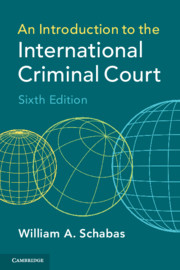Book contents
- An Introduction to the International Criminal Court
- An Introduction to the International Criminal Court
- Copyright page
- Contents
- Preface
- Abbreviations
- 1 Creation of the Court
- 2 The Court Becomes Operational
- 3 Jurisdiction
- 4 Triggering the Jurisdiction
- 5 Admissibility
- 6 General Principles of Criminal Law
- 7 Investigation and Pre-Trial Procedure
- 8 Trial and Appeal
- 9 Punishment
- 10 Victims of Crimes and Their Concerns
- 11 Structure and Administration of the Court
- Appendices
- Bibliography
- Index
2 - The Court Becomes Operational
Published online by Cambridge University Press: 09 June 2020
- An Introduction to the International Criminal Court
- An Introduction to the International Criminal Court
- Copyright page
- Contents
- Preface
- Abbreviations
- 1 Creation of the Court
- 2 The Court Becomes Operational
- 3 Jurisdiction
- 4 Triggering the Jurisdiction
- 5 Admissibility
- 6 General Principles of Criminal Law
- 7 Investigation and Pre-Trial Procedure
- 8 Trial and Appeal
- 9 Punishment
- 10 Victims of Crimes and Their Concerns
- 11 Structure and Administration of the Court
- Appendices
- Bibliography
- Index
Summary
The Statute entered into force on 1 July 2002. Judges, the Prosecutor and the Registrar had been elected by mid-2003. After signing the Statute at the end of 2000, the United States moved to a position of hostility towards the Court, then became more mellow as it determined that its vital interests were not threatened. The Prosecutor developed a strategy of encouraging ‘self-referrals’, whereby Uganda, the Democratic Republic of the Congo and the Central African Republic sought the Court’s assistance in prosecuting anti-government forces. This led to the initial trials of rebel leaders from the Democratic Republic of the Congo. The Security Council referred the situation in Darfur, Sudan to the Court but provided no further assistance in apprehending suspects, including the President, Omar Al-Bashir. Using proprio motu authority, the Prosecutor undertook cases of post-election violence in Kenya and Côte d’Ivoire. For the first decade of its activity, the Court’s attention was essentially confined to the African continent. A malaise developed in Africa and a few African States attempted to withdraw from the Statute. By then end of the 2010s, concerns were being expressed about the future of the Court, with calls for major reforms.
Keywords
- Type
- Chapter
- Information
- An Introduction to the International Criminal Court , pp. 23 - 50Publisher: Cambridge University PressPrint publication year: 2020

